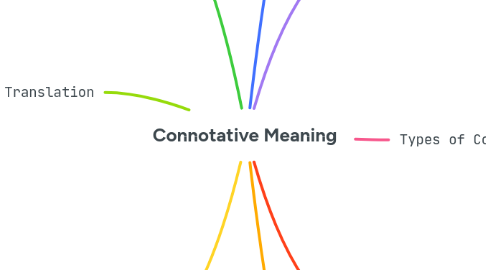
1. Measurement of Connotative Meaning
1.1. Osgood, Suci, and Tannenbaum's Semantic Differential
1.1.1. A method for measuring the connotative meanings of words using bipolar scales.
1.2. Findings
1.2.1. Studies have shown that people generally agree on the connotative meanings of words, despite individual differences.
2. Connotations in Translation
2.1. Challenges
2.1.1. Translating words with different connotations in the source and target languages.
2.2. Strategies
2.2.1. Techniques for handling connotations in translation, such as explicit translation, implicit translation, paraphrasing, and omission.
2.3. Cultural Sensitivity
2.3.1. The importance of considering cultural differences in connotations when translating.
3. Connotations in Discourse
3.1. Pronunciation
3.1.1. The way a word is pronounced can influence its connotations.
3.2. Words and Idioms
3.2.1. The choice of words and idioms can convey connotations.
3.3. Discourse Style
3.3.1. The overall style of a text or utterance can have connotative effects.
3.4. Themes
3.4.1. The subject matter of a message can influence its connotations.
4. Definition and Characteristics
4.1. Definition
4.1.1. The emotional or associative meanings of words beyond their literal definitions.
4.2. Distinction from Denotation
4.2.1. The literal, dictionary definition of a word.
4.3. Cultural Variation
4.3.1. Connotations can vary across different cultures and languages.
4.4. Subjectivity
4.4.1. Connotations can be personal and subjective, influenced by individual experiences and associations.
5. Sources of Connotative Meaning
5.1. Speakers
5.1.1. The people who use the word can influence its connotations.
5.2. Circumstances
5.2.1. The context in which the word is used can affect its connotations.
5.3. Linguistic Setting
5.3.1. The surrounding words and phrases can impact a word's connotations.
6. Types of Connotations
6.1. Positive Connotations
6.1.1. Words associated with pleasant emotions or positive qualities.
6.2. Negative Connotations
6.2.1. Words associated with unpleasant emotions or negative qualities.
6.3. Neutral Connotations
6.3.1. Words without strong positive or negative connotations.
7. Connotations and Taboo
7.1. Verbal Taboo
7.1.1. Words that are avoided due to strong positive or negative connotations.
7.2. Positive Taboo
7.2.1. Words associated with fear or awe.
7.3. Negative Taboo
7.3.1. Words associated with disgust or revulsion.
8. Levels of Usage
8.1. Technical Language
8.1.1. Specialized vocabulary used in specific fields or professions.
8.2. Formal Language
8.2.1. Language used in official or serious contexts.
8.3. Informal Language
8.3.1. Language used in casual or everyday situations.
8.4. Casual Language
8.4.1. Language used in relaxed or informal settings.
8.5. Intimate Language
8.5.1. Language used within close relationships.
